Content is from Kirkbride et al. 2006Kirkbride et al. 2006:
Kirkbride JH, Jr, Gunn CR, and Dallwitz MJ. 2006. Family guide for fruits and seeds, vers. 1.0. Accessed September 2020-January 2022. URL: https://nt.ars-grin.gov/seedsfruits/keys/frsdfam/index.cfm ., without modification.
Updates are forthcoming.
Fruits: Pistil(s) compound, or simplesimple:
fruit formed from a single flower with one pistil, solitary carpel or several fused carpels
; 1 (-U); with carpels united. Fruit pericarpium; simplesimple:
fruit formed from a single flower with one pistil, solitary carpel or several fused carpels
; capsulecapsule:
a dry, dehiscent fruit derived from a compound ovary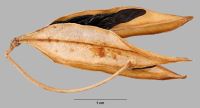 (which may be gaping or closed), or berryberry:
(which may be gaping or closed), or berryberry:
an indehiscent, fleshy fruit with one or a few to many seeds. The flesh may be homogenous throughout. Or, if the outer part is hard, firm, or leathery, referred to as an hesperidium. Septa are present in some, and the seeds may be arillate or with a fleshy testa. (Oehradenus), or folliclefollicle:
(Oehradenus), or folliclefollicle:
a dry to (rarely) fleshy fruit derived from a single carpel that opens along a single longitudinal suture, derived from a single, superior, simple ovary; the seeds may be arillate or with a fleshy testa (Sesamoides (Astrocarya) - last 2 not Spjut); pyxidium capsulecapsule:
(Sesamoides (Astrocarya) - last 2 not Spjut); pyxidium capsulecapsule:
a dry, dehiscent fruit derived from a compound ovary (Reseda); capsulecapsule:
(Reseda); capsulecapsule:
a dry, dehiscent fruit derived from a compound ovary not inflated; capsulecapsule:
not inflated; capsulecapsule:
a dry, dehiscent fruit derived from a compound ovary without operculumoperculum:
without operculumoperculum:
a dehiscent cap (or lid) of a seed or fruit that opens during germination or dehiscence
 ; berryberry:
; berryberry:
an indehiscent, fleshy fruit with one or a few to many seeds. The flesh may be homogenous throughout. Or, if the outer part is hard, firm, or leathery, referred to as an hesperidium. Septa are present in some, and the seeds may be arillate or with a fleshy testa. indehiscent; berryberry:
indehiscent; berryberry:
an indehiscent, fleshy fruit with one or a few to many seeds. The flesh may be homogenous throughout. Or, if the outer part is hard, firm, or leathery, referred to as an hesperidium. Septa are present in some, and the seeds may be arillate or with a fleshy testa. without central placental mass; without persistent central column; not within accessory organ(s); 1-seeded to many-seeded; 1-seeded (to many); with (2–)3(–7)-carpellate ((2-)3–6(-7)); with carpels united, or separate; with carpels remaining united at maturity, or separating at maturity; with carpels radiating at maturity (Sesamoides, Caylusia), or not radiating at maturity; with carpels separating at stylestyle:
without central placental mass; without persistent central column; not within accessory organ(s); 1-seeded to many-seeded; 1-seeded (to many); with (2–)3(–7)-carpellate ((2-)3–6(-7)); with carpels united, or separate; with carpels remaining united at maturity, or separating at maturity; with carpels radiating at maturity (Sesamoides, Caylusia), or not radiating at maturity; with carpels separating at stylestyle:
in a flower, the narrow and elongated part of the pistil between the stigma and the ovary; sometimes persisting in fruit ; without sterilesterile:
; without sterilesterile:
lacking male and/or female reproductive parts; also, not producing fruit or seed
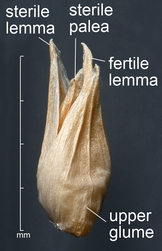 carpels; not sulcatesulcate:
carpels; not sulcatesulcate:
surface relief—having one or more elongate, relatively narrow and shallow depressions or grooves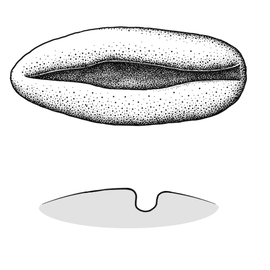 ; apexapex:
; apexapex:
the point farthest from the point of attachment, or the "tip" of an organ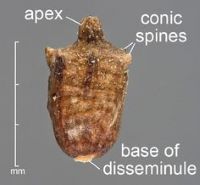 not beaked; wall chartaceouschartaceous:
not beaked; wall chartaceouschartaceous:
=papery, papyraceous
, or crustaceouscrustaceous:
texture—thin, dry, indurate, and brittle
; indehiscentindehiscent:
not opening on its own, as in a fruit
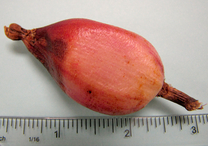 , or dehiscentdehiscent:
, or dehiscentdehiscent:
(v. dehisce) splitting open at maturity to release contents (of a fruit)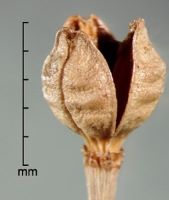 . Dehiscentdehiscent:
. Dehiscentdehiscent:
(v. dehisce) splitting open at maturity to release contents (of a fruit) unit seed(s). Dehiscentdehiscent:
unit seed(s). Dehiscentdehiscent:
(v. dehisce) splitting open at maturity to release contents (of a fruit) passively (assumed); and shedding seeds; without replumreplum:
passively (assumed); and shedding seeds; without replumreplum:
the rim, formed by the persistent placentas, and connected by a false septum in Brassicaceae fruits. The fruit valves are attached to this rim and separate from it in dehiscent fruits.
. Epicarpepicarp:
outer layer of fruit wall or pericarp, if divided into layers; note here used synonymously with exocarp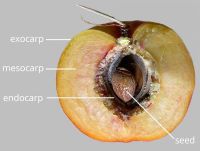 blue; durable; leatheryleathery:
blue; durable; leatheryleathery:
texture—moderately thick, tough, and very pliable
, or membranousmembranous:
texture—extremely thin, pliable, and fairly tough
, or crustaceouscrustaceous:
texture—thin, dry, indurate, and brittle
; without armature; smooth, or not smooth; punctatepunctate:
surface relief—dotted with pits or with translucent, sunken glands or with colored dots, similar to pitted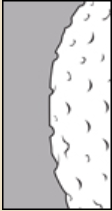 glandularglandular:
glandularglandular:
surface relief—covered with small, raised secretory glands, regular or irregularly shaped, translucent or opaque, and maybe distinctly colored ; without wing(s); without apicalapical:
; without wing(s); without apicalapical:
at or pertaining to the end of the seed or fruit distal from its point of attachment (i.e., base)
respiratory hole. Mesocarpmesocarp:
the middle layer of the pericarp, if divided into layers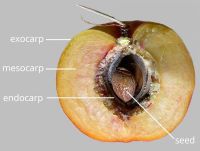 present, or absent. Endocarpendocarp:
present, or absent. Endocarpendocarp:
the inner layer of the pericarp, if divided into layers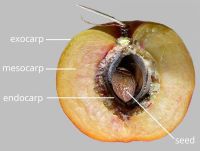 present, or absent; not separating from exocarpexocarp:
present, or absent; not separating from exocarpexocarp:
outer layer of fruit wall or pericarp, if divided into layers; note here used synonymously with epicarp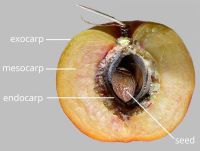 ; thinthin:
; thinthin:
having or being of relatively little depth
; not splitting into 1-seeded pyrenes; smooth; without wing; without operculumoperculum:
a dehiscent cap (or lid) of a seed or fruit that opens during germination or dehiscence
 ; without secretory cavities; without mechanism for seedling escape; without grooves; without longitudinallongitudinal:
; without secretory cavities; without mechanism for seedling escape; without grooves; without longitudinallongitudinal:
of or relating to length or the lengthwise dimension
ridges. Funiculusfuniculus:
(alt. funicle) stalk connecting the ovule (later seed) to the ovary (later fruit) placenta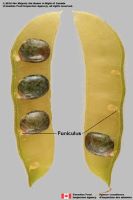 short; short without seed bearing hooks (retinacula); not persisting in fruit after seed shed.
short; short without seed bearing hooks (retinacula); not persisting in fruit after seed shed.
Seeds: Arilaril:
(broad sense) appendicular structure that wholly or partly envelops a seed and is produced from or a modification of the funicle, raphe, or outer integument; usually fleshy or pulpy, sometimes spongy or tufted-capillate, often brightly colored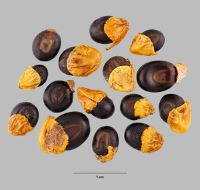 present, or absent; an arillike structure. Arillike structure falling with seed a carunclecaruncle:
present, or absent; an arillike structure. Arillike structure falling with seed a carunclecaruncle:
a localized outgrowth of the seed coat near the hilum of the seed; it functions as an elaiosome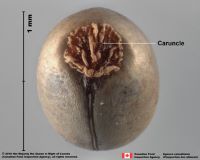 (Reseda or is it an aril?); carunculoid (stalklike). Seed minute to larger than minute; less than 1 mm long to 1 to less than 5 mm long; 0.5–3 mm long; reniformreniform:
(Reseda or is it an aril?); carunculoid (stalklike). Seed minute to larger than minute; less than 1 mm long to 1 to less than 5 mm long; 0.5–3 mm long; reniformreniform:
2D or 3D shape—kidney-shaped , or hippocrepiformhippocrepiform:
, or hippocrepiformhippocrepiform:
3D shape—horseshoe-shaped
; in transectiontransection:
a cross section; representing a plane made by cutting across an organ at a right angle to its length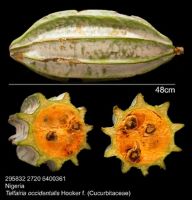 tereteterete:
tereteterete:
approximately circular in cross section; width and thickness approximately equal
 ; not bowl shaped; not nutlike; without winglike beakbeak:
; not bowl shaped; not nutlike; without winglike beakbeak:
a usually firm, terminal appendage, sometimes tapered ; without caudatecaudate:
; without caudatecaudate:
tapering to a long, tail-like appendage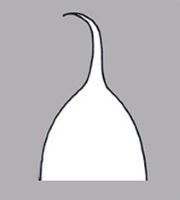 appendage(s); at maturity with food reserves, or without food reserves; with endospermendosperm:
appendage(s); at maturity with food reserves, or without food reserves; with endospermendosperm:
nutritive starch- and oil-containing tissue present in many seeds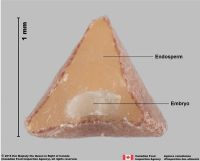 and perispermperisperm:
and perispermperisperm:
seed nutritive tissue comparable to the endosperm, but derived from the nucellus (maternal tissue)
; without canavanine. Sarcotestasarcotesta:
pulpy or fleshy outer layer of the seed coat, simulates aril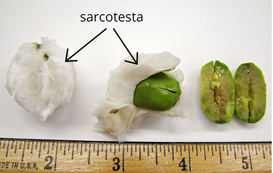 absent. Testatesta:
absent. Testatesta:
seed coat
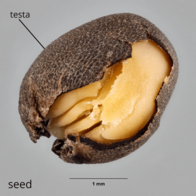 present (& outer layer may flake off or detach but inner layers always present); without markedly different marginalmarginal:
present (& outer layer may flake off or detach but inner layers always present); without markedly different marginalmarginal:
at, on, or close to the margin or border
tissue; without fleshyfleshy:
texture—fairly firm and dense, juicy or at least moist, and easily cut
or leatheryleathery:
texture—moderately thick, tough, and very pliable
layer over hard layer; tight; shinyshiny:
uniformly reflecting a high proportion of incident light at all angles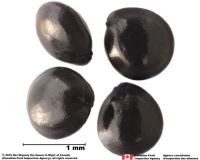 , or dulldull:
, or dulldull:
reflecting only a low proportion of incident light, with no apparent sheen ; surface unsmooth, or smooth; surface with discreet raised features, or merged raised features; surface papillatepapillate:
; surface unsmooth, or smooth; surface with discreet raised features, or merged raised features; surface papillatepapillate:
surface relief—bearing minute, distinct, broad-based projections, tapering to a rounded apex , or verrucoseverrucose:
, or verrucoseverrucose:
surface relief—warty, covered with wart-like projections
; surface rugoserugose:
=wrinkled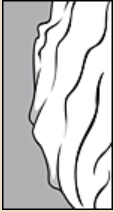 ; without crease or line separating cotyledons from hypocotyl-radicle, or with crease or line separating cotyledons from hypocotyl-radicle; without notch along margin where cotyledons from hypocotyl-radicle tip approach each other, or with notch along margin where cotyledons from hypocotyl-radicle tip approaching each other; without glands; without bristles; glabrousglabrous:
; without crease or line separating cotyledons from hypocotyl-radicle, or with crease or line separating cotyledons from hypocotyl-radicle; without notch along margin where cotyledons from hypocotyl-radicle tip approach each other, or with notch along margin where cotyledons from hypocotyl-radicle tip approaching each other; without glands; without bristles; glabrousglabrous:
without hairs
; without wings; without collar; without operculumoperculum:
a dehiscent cap (or lid) of a seed or fruit that opens during germination or dehiscence
 ; colored; monochrome; black, or brown (all shades), or green, or red, or gray (latter three ish); crustaceouscrustaceous:
; colored; monochrome; black, or brown (all shades), or green, or red, or gray (latter three ish); crustaceouscrustaceous:
texture—thin, dry, indurate, and brittle
; not becoming mucilaginousmucilaginous:
resembling mucilage; moist and sticky
when wetted; technically correct surrounding food reserve, or surrounding embryo (essentially). Endospermendosperm:
nutritive starch- and oil-containing tissue present in many seeds development nuclear; moderate (often capping cotyledons and/or between cotyledons & hypocotylhypocotyl:
development nuclear; moderate (often capping cotyledons and/or between cotyledons & hypocotylhypocotyl:
portion of the embryonic axis below the cotyledons and above the radicle
), or copious (Ochradenus); without fatty acid containing cyclopropene; without apicalapical:
at or pertaining to the end of the seed or fruit distal from its point of attachment (i.e., base)
lobes; without chlorophyll; without isodiametric faceted surface; without odor. Perispermperisperm:
seed nutritive tissue comparable to the endosperm, but derived from the nucellus (maternal tissue)
opaqueopaque:
not transmitting light
. Embryo differentiated from food reserve; well developed; 1 per seed; nearly filling testatesta:
seed coat
 (trace or scanty food reserve); 1 times the length of food reserve; at one end of seed not extending into a depression or cup; linearlinear:
(trace or scanty food reserve); 1 times the length of food reserve; at one end of seed not extending into a depression or cup; linearlinear:
(shape) long, narrow, and uniform in width; (of embryo) embryo is straight and much longer than wide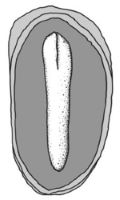 ; C-shapedC-shaped:
; C-shapedC-shaped:
2D-shape—semiannulate, curved into the shape of the letter 'C'
, or arcuate; parallel to seed length; with cotyledons gradually connected to hypocotyl-radicle; without coleorhiza; without simmondsin; with cotyledons containing oils; without stomata; not green; with 2 or more cotyledons. Cotyledons 2; well developed, or moderately developed; 0.4–0.5 times length of embryo; as wide as hypocotyl-radicle; 1 times wider than hypocotyl-radicle; not concealing hypocotyl-radicle; not foliaceous; thickthick:
having or being of relatively great depth
; flat, or once-folded; smooth; with apicesapex:
the point farthest from the point of attachment, or the "tip" of an organ entire; with margins separate; basally entire; equal in size, or unequal in size; more or less unequal (one slightly larger); not punctatepunctate:
entire; with margins separate; basally entire; equal in size, or unequal in size; more or less unequal (one slightly larger); not punctatepunctate:
surface relief—dotted with pits or with translucent, sunken glands or with colored dots, similar to pitted dotted. Hypocotyl-radicle moderately developed, or well developed; straight; not thickened. Plumule undeveloped.
dotted. Hypocotyl-radicle moderately developed, or well developed; straight; not thickened. Plumule undeveloped.
Literature specific to this family: Abdallah, M.S. & H.C.D. de Wit. 1968 & 1978. The Resedaceae. Meded. Landbouwhoogeschool 67:1–98, figs. 1–17, 78:99–416, figs. 18–91.
General references: Baillon, H.E. 1866–95. Histoire des plantes, 13 vols. Hachette & Co., Paris, Corner, E.J.H. 1976. The seeds of Dicots, esp. vol. 2. Cambridge University Press, New York, Cronquist, A. 1981. An integrated system of classification of flowering plants, 1,262 p. Columbia University Press, New York, Engler, A. & K. Prantl. 1924 and onward. Die Natürlichen Pflanzenfamilimien. W. Engelman, Leipzig, Gaertner, J. 1788–1805. De fructibus et seminibus plantarum. The Author, Stuttgart, Goldberg, A. 1986 (dicots) & 1989 (monocots). Classification, evolution, and phylogeny of the familes of Dicotyledons. Smithsonian Contr. Bot. 58 for dicots (314 pp.) & 71 for monocots (74 pp.). [Goldberg's illustrations are reproduced from older publications and these should be consulted], Gunn, C.R., J.H. Wiersema, C.A. Ritchie, & J.H. Kirkbride, Jr. 1992 & amendments. Families and genera of Spermatophytes recognized by the Agricultural Research Service. Techn. Bull. U.S.D.A. 1796:1–500, LeMaout, E. & J. Decaisne. 1876. A general system of botany, 1,065 p. Longmans, Green, & Co., London, Mabberley, D.J. 1987. The plant-book, 706 p. Cambridge University Press, Cambridge, Martin, A.C. 1946. The comparative internal morphology of seeds. Amer. Midl. Naturalist 36:513–660, and Spjut, R.W. 1994. A systematic treatment of fruit types. Mem. New York Bot. Gard. 70:1–182.